后期风堆堆肥过程中二氧化碳排放的特征
IF 3.3
3区 环境科学与生态学
Q2 ENVIRONMENTAL SCIENCES
引用次数: 0
摘要
当有机废物通过堆肥转化为可用的改良剂时,与微生物分解有机物相关的二氧化碳排放量很大。虽然活性堆肥阶段在短时间内产生的排放量最大,但堆肥在成熟阶段期间和之后通常可以储存更长的时间,从而增加累积排放量。因此,本研究的目标是检查与原位排放采样相关的空间和时间变异性,同时确定风车堆肥设施在成熟阶段期间和之后对排放的环境和化学控制。在 2020 年 6 月至 11 月期间,对四个不同年龄和组成的风堆进行了共计 665 次通量测量。采用因子方差分析(ANOVA)确定取样地点之间的变异性,同时采用多元线性回归确定对二氧化碳通量影响最大的参数。排放量随时间的变化很大,这与环境温度有关。在夏季,每个风箱的排放量峰值在 5.0 至 32.3 克 CO2 m-2 hr-1 之间。随着气温降低,风车的排放量下降了 62% 到 86%,一般低于 2 克 CO2 m-2 hr-1。风车上最顶端的取样位置与其他取样位置之间存在显著差异,二氧化碳排放量高出 33%-100% 不等。表面温度、含水量和内部温度等环境控制因素对排放量的影响最大(R2 = 0.62)。有机氮、碳、pH 值、镁和硝酸盐等化学特性也有显著影响(R2 = 0.43)。这项研究表明,包括温度和湿度在内的环境因素对成熟堆肥的排放率影响最大。研究发现,有机氮对二氧化碳通量有明显的负面影响,这表明有机氮的增加将有助于在成熟阶段后保留碳,从而降低总排放量。本文章由计算机程序翻译,如有差异,请以英文原文为准。
Characterization of carbon dioxide emissions from late stage windrow composting
As organic waste is converted to usable amendments via composting, there are large CO2 emissions associated with the decomposition of organic matter via microorganisms. While the active composting phase produces the largest emissions over a short duration, compost can often be stored during and after the maturation phase for much longer periods of time, increasing cumulative emissions. As such, the objectives of this study were to examine the spatial and temporal variability associated with in situ emissions sampling while identifying the environmental and chemical controls on emissions in windrow composting facilities during and after the maturation phase. A total of 665 flux measurements were taken from four windrows representing different ages and compositions between June and November 2020. Factorial analysis of covariance (ANOVA) was used to determine the variability between sampling locations, while multiple linear regression was used to identify those parameters which had the most influence on CO2 flux. Emissions showed significant variability over time that were attributed to ambient temperatures. During the summer, each windrow reached peak emissions between 5.0 and 32.3 g CO2 m-2 hr-1. As temperatures cooled, the windrows saw a 62%–86% decline in emissions, generally falling below 2 g CO2 m-2 hr-1. Significant differences occurred between the top-most sampling location and all others on the windrow, emitting between 33%–100% more CO2 . The environmental controls of surface temperature, moisture content, and internal temperature showed the highest influence on emissions (R2 = 0.62). Chemical properties including organic nitrogen, carbon, pH, magnesium, and nitrate also showed significant influence (R2 = 0.43). This research has shown that environmental factors including temperature and moisture show the strongest influence over emission rates in mature compost. A significant negative effect of organic nitrogen on CO2 flux was found, indicating that increased presence of organic nitrogen would aid in the retention of carbon after the maturation phase, acting to lower total emissions.
求助全文
通过发布文献求助,成功后即可免费获取论文全文。
去求助
来源期刊

Frontiers in Environmental Science
Environmental Science-General Environmental Science
CiteScore
4.50
自引率
8.70%
发文量
2276
审稿时长
12 weeks
期刊介绍:
Our natural world is experiencing a state of rapid change unprecedented in the presence of humans. The changes affect virtually all physical, chemical and biological systems on Earth. The interaction of these systems leads to tipping points, feedbacks and amplification of effects. In virtually all cases, the causes of environmental change can be traced to human activity through either direct interventions as a consequence of pollution, or through global warming from greenhouse case emissions. Well-formulated and internationally-relevant policies to mitigate the change, or adapt to the consequences, that will ensure our ability to thrive in the coming decades are badly needed. Without proper understanding of the processes involved, and deep understanding of the likely impacts of bad decisions or inaction, the security of food, water and energy is a risk. Left unchecked shortages of these basic commodities will lead to migration, global geopolitical tension and conflict. This represents the major challenge of our time. We are the first generation to appreciate the problem and we will be judged in future by our ability to determine and take the action necessary. Appropriate knowledge of the condition of our natural world, appreciation of the changes occurring, and predictions of how the future will develop are requisite to the definition and implementation of solutions.
Frontiers in Environmental Science publishes research at the cutting edge of knowledge of our natural world and its various intersections with society. It bridges between the identification and measurement of change, comprehension of the processes responsible, and the measures needed to reduce their impact. Its aim is to assist the formulation of policies, by offering sound scientific evidence on environmental science, that will lead to a more inhabitable and sustainable world for the generations to come.
 求助内容:
求助内容: 应助结果提醒方式:
应助结果提醒方式:


